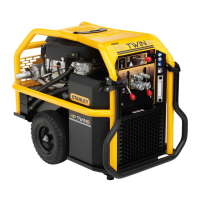HP TWIN8 User Manual ◄ 13
COLD WEATHER STARTUP
1. Use the procedures described under “STARTUP”
and then follow the procedure below.
2. Hydraulic uids are thicker in cold weather.
Therefore, it is recommended that the engine be run
at low idle long enough to bring the uid temperature
up to a minimum of 50 °F/10 °C.
3. If the tools and tool hoses are cold, it is recommended
to allow hydraulic uid to circulate through the tool
hoses until warm, before using the tool.
of operation. Change more often if cold, moist or
dusty conditions exist.
• Check oil cooler for debris. Remove debris with air
pressure.
BATTERY MAINTENANCE
• If the power unit is not in use for two or more
months, check the battery once a month and
charge if the battery voltage is below 12.5V.
Charge at 1.3A for 5-10 hours.
• If the battery voltage is below 12.0V, charge at 1.3A
for 12-18 hours, let the battery sit for 1-2 hours and
check the voltage. If the voltage is not 12.5V or
greater, replace the battery.
• Always charge using a charger as rated as close to
1.3A as possible.
• Checking battery voltage and charging can be
done through the 12V marine plug on the battery
cover when using an appropriate adapter.
STORAGE
• Clean the unit thoroughly before storage. Do not use
water pressure.
• Always store the unit in a clean and dry facility.
• If the unit will be stored for a prolonged period (over
30 days), add a fuel additive to the fuel tank to
prevent the fuel from gumming. Run engine for 2
minutes to circulate the additive throughout the fuel
system.
•
When storing fuel or equipment with fuel in the tank,
store away from appliances that have pilot lights or
other ignition sources as they can ignite fuel vapors.
Replace crankcase oil with new oil.
• Remove spark plugs and pour approximately 1
ounce (30 ml) of engine oil into each cylinder.
Replace spark plugs and crank the engine slowly to
distribute the oil.
• Check hydraulic reservoir for water. If water is
found, change the oil and circulate it through the
tool hose and tool. (See “HYDRAULIC SYSTEM
MAINTENANCE” on page 13).
• Disconnect tool hoses.
ENGINE MAINTENANCE
Follow the maintenance schedule and general
maintenance instructions and emissions control
maintenance in the engine operators manual furnished
with the power unit.
Fuel system emissions maintenance:
• Check the fuel system emissions components
once a year to verify that the components are in
good condition and do not show signs of leakage. If
leakage is found, replace part.
• Check fuel lines, tank, cap and ttings frequently for
cracks or leaks. Replace if necessary.
• Clean the fuel cap area of dirt and debris.
• Replacement parts must be the same and installed
in the same position as the original parts.
HYDRAULIC SYSTEM MAINTENANCE
• Check hydraulic uid level daily. Add uid per
specications in this manual. (See “3. HYDRAULIC
FLUID” on page 11.)
• Remove condensed moisture from the hydraulic
uid by pumping the hydraulic uid into a 5 gal/20 L.
container through the pressure hose. Make sure the
engine is at idle when performing this procedure.
When the hydraulic reservoir is empty turn the
engine off immediately.
• Allow the uid to sit long enough for the water to
settle to the bottom of the container. Slowly pour the
uid back into the hydraulic tank, avoiding the water
at the bottom of the container.
• Each day, check hydraulic lines and ttings for
leaks, kinks, etc. Do not use your hand to perform
this check.
• Change the hydraulic lter element every 200 hours
MAINTENANCE

